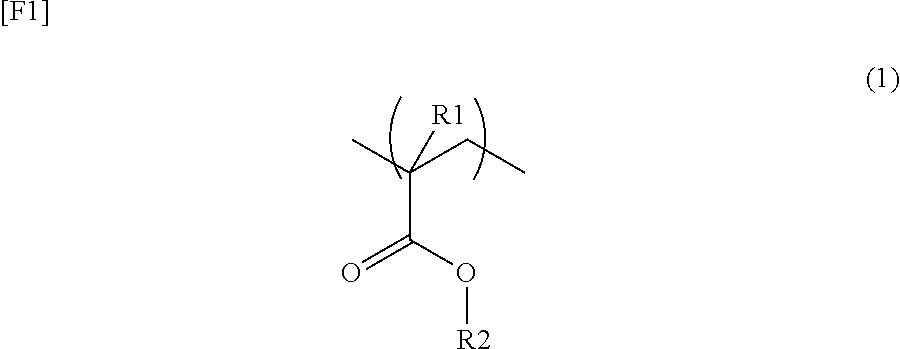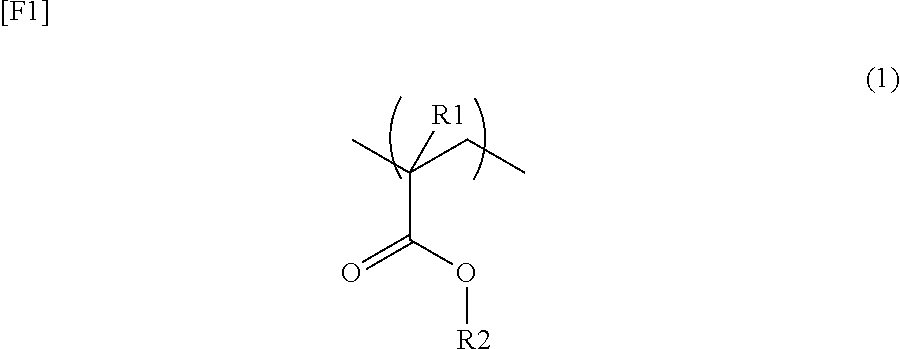Synthetic resin laminate
- Summary
- Abstract
- Description
- Claims
- Application Information
AI Technical Summary
Benefits of technology
Problems solved by technology
Method used
Image
Examples
synthesis example 1
Production of Photosensitive Hard Coating Material (C)
[0055]To a mixing layer equipped with agitation paddles, a composition containing 60 parts of tris(2-acroxyethyl) isocyanurate (product of Aldrich), 40 parts of neopentyl glycol oligoacrylate (trade name: Viscoat #215D, product of Osaka Organic Chemical Industry Ltd.), 2.8 parts of 2,4,6-trimethylbenzoyldiphenylphosphine oxide (trade name: DAROCUR TPO, product of Ciba Japan), and 1 part of benzophenone (product of Aldrich) was fed. The composition was stirred for one hour at a constant temperature of 40° C., to thereby yield a photosensitive hard coating material (C).
example 1
[0056]By means of a multilayer extrusion apparatus having a single screw extruder having a shaft diameter of 32 mm, a single screw extruder having a shaft diameter of 65 mm, a feed block coupled to all the extruders, and a T-die coupled to the feed block, a synthetic resin laminate plate was produced. Specifically, a methyl methacrylate-styrene (78:22) copolymer resin [trade name: Estyrene MS750, product of Nippon Steel Chemical Co., Ltd.] (resin B1) was continuously fed to the single screw extruder having a shaft diameter of 32 mm and extruded under at a cylinder temperature of 250° C. and a discharge rate of 8 kg / h. Separately, a methyl methacrylate-styrene (20:80) copolymer resin [trade name: Estyrene MS200, product of Nippon Steel Chemical Co., Ltd.] (resin A1) was continuously fed to the single screw extruder having a shaft diameter of 65 mm and extruded under at a cylinder temperature of 260° C. and a discharge rate of 50 kg / h. The feed block coupled to all the extruders was e...
example 2
[0058]The procedure of Example 1 was repeated, except that an acrylonitrile-styrene (20:80) copolymer resin [trade name: Stylac AST8701, product of Asahi Kasei Chemicals Corporation] (resin A2) was used instead of resin A1 used in Example 1, to thereby yield a synthetic resin laminate of resin B1-resin A2-resin B1 and a synthetic resin laminate having a hard coat layer on the resin B1 layer; i.e., a laminate which had been subjected to a hard coating treatment. The thickness of the resultant synthetic resin laminate was 1.5 mm, and the thickness (single side) of the resin B1 layer was 90 μm near the center. Table 1 show the evaluations. As is clear from Table 1, all of the transparency, scratch resistance, interlayer adhesion, adhesion to hard coat layer, weather resistance, and anti-warpage property were good, and the total evaluation of the laminate was good.
PUM
| Property | Measurement | Unit |
|---|---|---|
| Electrical resistance | aaaaa | aaaaa |
| Adhesion strength | aaaaa | aaaaa |
| Ratio | aaaaa | aaaaa |
Abstract
Description
Claims
Application Information
 Login to View More
Login to View More - R&D
- Intellectual Property
- Life Sciences
- Materials
- Tech Scout
- Unparalleled Data Quality
- Higher Quality Content
- 60% Fewer Hallucinations
Browse by: Latest US Patents, China's latest patents, Technical Efficacy Thesaurus, Application Domain, Technology Topic, Popular Technical Reports.
© 2025 PatSnap. All rights reserved.Legal|Privacy policy|Modern Slavery Act Transparency Statement|Sitemap|About US| Contact US: help@patsnap.com



